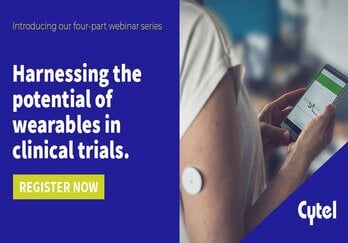The biostats and clinical overview of a growing clinical strategy

The past two years have witnessed a heightened interest in the use of wearables in clinical development. The unexpected changes to the industry ushered in by the COVID-19 pandemic has highlighted the need for remote monitoring and patient-centric outcomes and accelerated the changes in the trials conduct.
Below we identify six elements critical to integrating wearables into your clinical development program.
What are wearables?
Wearables are miniaturized devices (or sensors) that are used to collect a variety of measurements like activity and mobility, oxygen saturation, heart-rate, and more. They are increasingly used in clinical trials and have the ability to generate an evidence-base that is more reflective of patient focused outcomes. They can be used for a variety of medical purposes such as remote monitoring, but in the context of clinical development wearables can be used to measure physical or chemical information such as heat, pressure, and motion; measures which have a meaningful relationship with a clinical outcome being measured and evaluated within the context of a clinical trial.
The Challenge
Although wearables can capture numerous forms of data (e.g. heart rate, blood pressure, drug absorption), the challenge becomes connecting these data to clinically meaningful endpoints. Should a reported decrease in CO2 during sleep monitoring be considered hypoventilation, and if so is it best to consider it a respiratory event or a symptom of hypertension? This requires first demonstrating that the wearable captures CO2 accurately, but subsequently connecting it to a clinically meaningful endpoint.
As the uses of wearables increases, this demonstration of clinically meaningful endpoint becomes a central theme in data capture and analysis.
Clinical context
Wearables allow clinicians to focus on patient-centric and objective endpoints in clinical trials. For example, in cardiovascular trials, wearables like actigraphy can be used to evaluate a patient’s daily physical activity, which is a critical part of their quality of life. While enabling patient-centric measures, wearables based endpoints are also objective measures, especially when compared to patient-reported perception of their daily activity.
In a number of medical conditions wearables offer the possibility to collect more clinically meaningful data compared to traditional assessment during scheduled medical visits. For example, patients’ progression of symptoms and daily functionality can vary in some neurological conditions, and assessments obtained during regular visits may not reflect meaningful changes due to these daily fluctuations. In these cases, wearables will provide measurements which can reflect the disease’s development, and the true improvement or deterioration of daily functionality.
Establish Construct Validity
Construct validity requires demonstration that what is being measured has clinical relevance for the clinical trial. This takes consultation with multiple parties including those biostatisticians on the clinical development team.
Construct a Biomarker or clinical endpoint
Wearable-based measurements can be used as clinically relevant endpoint in drugs trials. For example, physical activity and mobility (for example measured by actigraphy) can be used as endpoint in clinical trials. At the first webinars, speaker will discuss examples of pivotal studies with wearable-based endpoints used as primary efficacy endpoints for FDA pivotal trial. Similarly, mobility (for example measured by actigraphy) might be a surrogate for other health outcomes.
Data captured by the wearable can also be a surrogate for a specific clinical endpoint. Earlier we discussed measures of CO2 as surrogates for respiratory events. An EEG headband might scan aspects of brain function. For all of the various examples, a sponsor must make the case that the quantifiable measurement relates to a reasonable, clinically meaningful endpoint. Therefore, it is important for clinicians and statisticians to collaborate earlier to determine how to ensure that a digital biomarker is a valid surrogate.
Identify the Needs of an Evidence Dossier
Supporting the use of mobile sensors within a clinical trial requires assembly of an evidence dossier to explain the (presumed) link between the disease and the measurement ascertained by the wearable, the reliability of the wearable in providing accurate measurements, the functional way in which the wearable will be used to assess various factors, and more. This takes much consultation and upfront work, but can set up a sponsor for a much strong clinical trial.
Obtain the Biostatistical Perspective
Wearables and new sensor technologies provide new types of data that are increasing both in size and complexity. Therefore, involvement of biostatisticians is critical in clinical development with wearables. Given the complexities of analyzing multidimensional data and constructing valid biomarkers and endpoints, engaging statisticians during R&D processes might prove valuable to forming a complete regulatory strategy.
Regulatory Strategy
Wearables-based endpoints can be used in the context of the clinical development of a specific drug, as well as a qualified endpoint for a specific disease. Regulatory agencies such as FDA and EMA have developed pathways for qualification of digital technology-based methodologies and encourage companies to engage with them and their teams early in the development process.
For example, the first wearable-based clinical endpoint has recently been approved by EMA, which now allows the use of stride velocity measured at the ankle, as a secondary endpoint in pivotal trials in Duchenne Muscular Dystrophy.
Selection and use of wearables in clinical trials therefore requires understanding of regulatory pathways for medicinal products as well as medical devices, which are involved different regulatory bodies.
All of these elements of wearables for clinical development require a richer understanding of clinical trial design. Cytel is therefore hosting a wearables and clinical development series to provide clinical trial sponsors with a new perspective on how to design these trials.
Click below to learn more.


